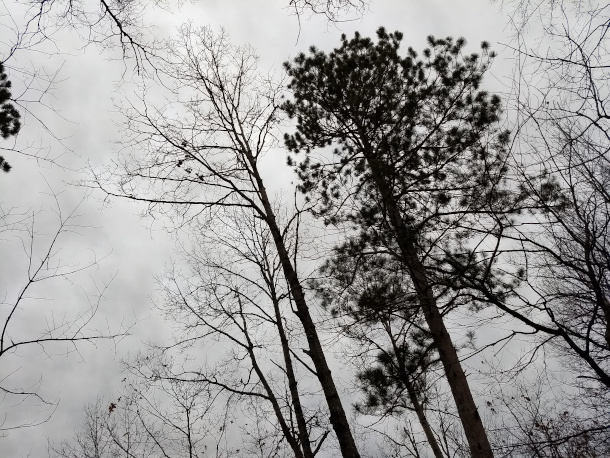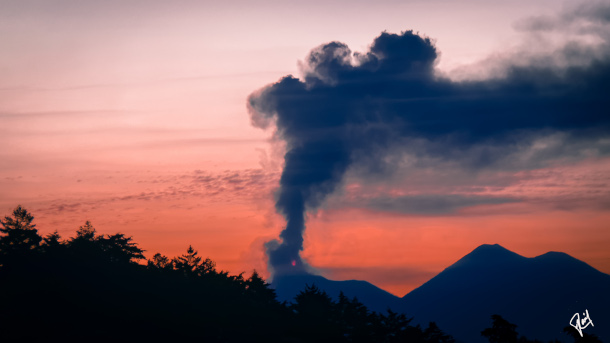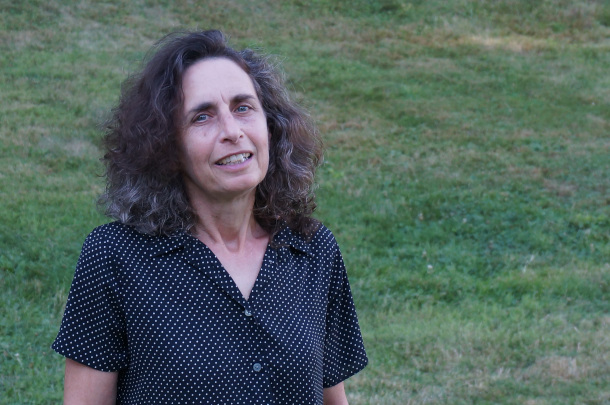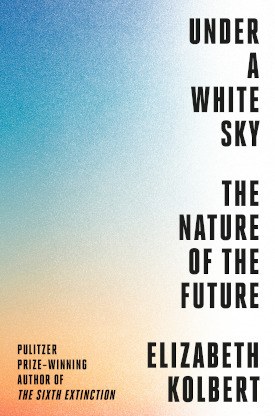Under a White Sky: The Nature of the Future
Air Date: Week of May 14, 2021

Solar geo-engineering could cool the planet but could leave behind a white sky. (Photo: Wilbur Ince, Flickr, CC BY 2.0)
Humans have altered the environment in innumerable ways. We’ve reversed rivers, introduced invasive species, and disrupted the climate. In the new book Under a White Sky: The Nature of the Future, Pulitzer Prize-winning writer Elizabeth Kolbert explores cutting edge and controversial technologies aimed at solving some of these problems. She joins Living on Earth’s Aynsley O’Neill.
Transcript
CURWOOD: It’s Living on Earth, I’m Steve Curwood.
In 2015, Elizabeth Kolbert won the Pulitzer Prize for her book The Sixth Extinction: An Unnatural History, which chronicles the human-made mass extinction crisis. Now she's out with a book that explores some cutting edge and controversial technologies that could address some of the world's most pressing environmental challenges. Her book, Under a White Sky: The Nature of the Future features scientists and other leaders who argue that in order to save the planetary systems that humans have altered, we must alter it again. Elizabeth Kolbert spoke with Living on Earth's Aynsley O'Neill about some of these controversial new technologies including the gene-editing process, CRISPR.
O'NEILL: When it comes to human hubris, there is the as always, cynics saying, well, you're playing God here. And what I'm talking about is microbiology and genetic engineering and CRISPR, physically changing the genetic composition of an organism. How does this process work? And where does that come into play in your book?

The Cane Toad is a poisonous amphibian that is invasive in Australia. Scientists are working on genetically modifying the animals to break their toxicity genes. (Photo: Brian Gratwicke, Flickr, CC BY 2.0)
KOLBERT: So CRISPR is a set of gene editing techniques that humans have borrowed from bacteria, interestingly enough. So what bacteria do is they can incorporate little bits of viral genetic material into their own genome. And then they use those as like mug shots, so that they can identify their enemies. They create these enzymes that can cut their enemy at very precise locations. And so now it's been discovered that you can program these enzymes basically, you can just program this system to cut DNA wherever you want to. And that's incredibly powerful. It really revolutionized gene editing. And that has opened up a lot of possibilities, including in the world of wildlife conservation. And one of the projects that I've visited in Australia, which was at a very, very bio secure one of the most secure facilities in the world in the city of Geelong, near Melbourne, they were gene editing an animal called a cane toad, which is an invasive, very destructive, invasive species. Cane toads are highly toxic. And so a lot of creatures eat them, you know, reptiles, snakes, lizards, birds, mammals, they're marsupials, now. And Australia, for for many reasons, mostly having to do with introduced species, is the mammalian extinction capital of the world. More of Australia's native mammals have gone extinct than anywhere else. And they're very, very interesting fauna, this unique marsupial fauna. So cane toads are considered a big, big threat, because you know, whatever eats them tends to drop dead. And certain animals have really, their populations have really plunged as soon as cane toads come into their territory. And so the idea behind this experiment was to see if you could sort of break the toxicity gene. There's one gene that creates an enzyme, which really makes their toxin much, much more potent. And so if you could basically disable that gene, which which they had done, the toads would be a lot less toxic.
O'NEILL: And there are those critics of CRISPR out there, what do they say? And how do you respond to that?
KOLBERT: You know, these animals were never leaving the lab, the ones that had been gene edited, but the question obviously arises, should they be allowed to leave the lab? And, you know, if they're aiding in a conservation project, would we want them you know, out there, you know, in that helping the world, helping a species, or maybe many species recover? These are really, really hard questions, and they do get into the playing God question. Now, one thing I will say is, you know, the guy who was in charge of this project that I visited, a scientist by the name of Mark Tizard, is very, very nice guy. He made the point to me, which I also thought was very compelling. Look, we're playing God all the time. You know, we are moving things around all the time. You know, your pets are not native species. You know, everything that you plant in your garden, much of it is probably not a native species. Every day in the ballast water of our supertankers, something like, you know, 10,000 species are being moved around. We're just doing it kind of willy nilly, we're not doing it purposefully. But we're moving whole genomes around and what gene editors do is they move, you know, a tiny sliver of DNA. So, you know, you can think about that we're playing God all the time. We're just ignoring that fact. So these are interesting things to think about. And that's really at the heart of the book, some of these questions, which are very, very difficult to answer, right. And I don't want to say there's a right answer here.
O'NEILL: You also describe something in the book known as the gene drive. Can you tell me about that, please.

Using “gene drive” technology, scientists have come up with mosquitos that could potentially deplete their own populations. (Photo: Eli Christman, Flickr, CC BY 2.0)
KOLBERT: So gene drive is a really interesting phenomenon. And gene drive exists in nature. There are genes, many of them probably, that defy the ordinary rules of inheritance. So you get two sets of chromosomes, right? One from your mom, one for your dad. And then when you go to pass on your genes, you will give one of those variants to your own children. And your mate, you know, will give one too. But some genes manipulate the rules of inheritance. They're very sly. And they pass themselves on more than 50% of the time, often, much more than 50% of the time. So those had been identified in the natural world. Now, what CRISPR allows you to do which is one of the many reasons that it's really a revolutionary technology is it allows you to, it itself is the whole system, the whole gene editing system is in effect encoded in DNA. It's a biological system. And you can insert that system into an organism, and basically program it to reprogram its own genetics, and then can be passed on generation after generation. And so what gene drive allows you to do is if you want a certain genetic variant to spread, you can insert that. And gene drive mosquitoes already exists. They are mosquitoes, that would pass on a trait that's quite deleterious, that makes it very, very difficult for them to reproduce. And so, in theory, at least, these mosquitoes as the generations go on, are basically doing themselves in. And it is planned or hoped by some people, how's that, that these mosquitoes that already exist, as I say, will be released in a part of Africa, where malaria rates are very high, and where a lot of people are dying of malaria. And it raises a lot of, you know, once again, profound questions. But gene drive could also be used for all sorts of other purposes. So a group that I visited also in Australia, also to a very bio secure facility was working on a gene drive mouse. And the idea behind the gene drive mouse was that invasive rodents are extremely destructive, you know, humans brought rodents everywhere, brought rats, brought mice. And they have been responsible for hundreds and probably more extinctions on islands, especially birds, like ground nesting birds. And so the idea, the hope, is you could create a gene, drive rodent, rat, or mouse. So you start with a mouse, that would also do the same thing as these mosquitoes, carry some deleterious trait that would eventually drive the population to zero. And you could release them on an island, once again, the hope, the theory, could release them on an island where they would only do in the other rodents on this island, they wouldn't do in you know, every rodent in in the world. But you know, that raises a lot of, you know, once again, complicated questions.
O'NEILL: It does raise a lot of interesting questions. And near the end of the book, you delve into a problem that some would say is much larger than genetically modifying individual animals. You explore geoengineering, the climate, in order to combat climate disruption. And that really is a truly global problem, and a truly global solution. So what would that geoengineering look like?

One way to cool the planet could be to solar-geoengineer the climate through releasing sulfur dioxide into the stratosphere, like volcanoes do. (Photo: RPP Photos, Flickr CC BY-NC 2.0)
KOLBERT: One of the really profound challenges of dealing with climate change is that carbon dioxide is not like a lot of other sort of more conventional pollutants, where if you stop pouring them into the air, they will drop out of the atmosphere and your problem will be, you know, after a certain amount of time, solved. Carbon dioxide hangs around, you know, for all intents and purposes forever. So if you got to a point where you said, okay, this amount of climate change is really, you know, a disaster, either humanitarian disaster or an ecological disaster, it would be extremely difficult to reverse that or, you know, get rid of it in a human timescale. And the only idea that people have come up with, scientists have come up with where you could actually reverse climate change, you often hear people talking about reversing climate change. But really, there's no way to reverse climate change except through solar geoengineering, where you would counter the effects of all the CO2 in the air by pouring another chemical compound, potentially sulfur dioxide, potentially calcium carbonate into the stratosphere, little tiny particles that would reflect, have a reflective quality would reflect sunlight back out to space and basically diminish the amount of direct sunlight that was hitting the earth. And that would have a cooling effect. And we know that this can be done. Because volcanoes do it. When you get a big volcanic eruption. It spews a lot of sulfur dioxide into the stratosphere. And that creates these tiny little droplets that are called aerosols. And those reflect sunlight back to space, you get these fantastic sunsets, and you get cooling. It's temporary, because eventually that drops out of the stratosphere. But so you'd have to constantly replenish these particles. But that's the idea.
O'NEILL: And that would create the white sky that your book is talking about living under.
KOLBERT: Yes, exactly. One of the many potential side effects of, you know, trying to re-engineer the stratosphere is that it would change the reflectivity of the stratosphere in a way that would turn the sky you know from very blue to more whitish. So the first step first question that really needs to be answered is are we going to even allow experiments to go forward. If we don't allow even experiments to go forward then never know if it works or not.

Elizabeth Kolbert is a journalist and author who has contributed to the New Yorker for the last two decades. (Photo: John Kleiner)
O'NEILL: And among these questions, there is the scientific. And then there's also the ethical questions. There's the global conflict questions. There's all these different things that have to be a factor in making decisions.
KOLBERT: Yes, absolutely, it really brings to the fore. I mean, there are two ways that we're really messing around with what for lack of a better word I will call natural systems. And one of them is intentionally, and one of them is unintentionally. And, you know, climate change, as we've discussed, is the unintended side effect of industrialization and of living the way we do, and then we will have to decide, okay, do we want to intentionally intervene here we've created, there's so much damage that we need to try to intentionally do something, and that does raise a lot of different questions. But, you know, the sad fact is that we have unintentionally, these questions already are questions we should be asking, because, you know, what we're doing just the way we lead our daily lives here in the U.S. certainly is impacting people all around the planet, you know, including a lot of people who had very little to do with creating the problem. So the possibilities, you know, for global conflict over climate change, they're also very real. But I think that the idea of intervening intentionally raises that to a whole new level.
O'NEILL: And now, I think it is not inaccurate to say that your book really brings up a lot more questions than answers. What should we make of that?

In addition to Under a Whte Sky, Elizabeth Kolbert is the author of Field Notes from a Catastrophe: Man, Nature, and Climate Change and The Sixth Extinction, for which she won the Pulitzer Prize. (Image Courtesy of Penguin Random House)
KOLBERT: Well, I thought of making the epigraph of the book a quote from a British environmental writer and activist, a guy named Paul Kingsnorth, who I think has written some very interesting stuff. And he, I'll try to get the quote, as close as possible. He says, you know, at a time like this, I'm not really sure anyone has any useful answers, but we can try to raise useful questions. And I think that, that is what I'm trying to do. I think what I'm also trying to do with the book is really bring home how extraordinary the time that we live in is, you know, I don't think we've really fully come to appreciate that we live in an unprecedented moment, I mean, truly unprecedented in Earth history, where one species is changing the world at a remarkable rate, a rate, you know, equaled only by the great catastrophes in earth history, like asteroid impacts, you know, very, very fast by geological standards. It doesn't seem that way to us, you know, we go about our lives, we drive our cars, you know, we used to go to work, we used to go to restaurants, but all these things that are, you know, pumping CO2 into the atmosphere, changing the way that, you know, land is used, changing the surface of the earth, changing the atmosphere, we're now thinking of mining the deep sea. That will change the surface of the sea floor. We're just a remarkable creature that has this remarkable power to change the world. And now we're suddenly, not suddenly, but we're, it's dawning on us. Wow, some of these are really dangerous changes, I mean, really dangerous. And what are we going to do? And that gets a little bit back to the, you know, can we solve these problems with the same thinking that got us into them? Can we solve them at all? You know, these are really the big questions of our time, I think.
CURWOOD: That’s Elizabeth Kolbert, author of Under a White Sky: The Nature of the Future speaking with Living on Earth’s Aynsley O’Neill.
Links
More on the book, Under a White Sky (Affiliate link helps donate to LOE and local indie bookstores)
A passage from Under a White Sky as published in the New Yorker
Living on Earth wants to hear from you!
Living on Earth
62 Calef Highway, Suite 212
Lee, NH 03861
Telephone: 617-287-4121
E-mail: comments@loe.org
Newsletter [Click here]
Donate to Living on Earth!
Living on Earth is an independent media program and relies entirely on contributions from listeners and institutions supporting public service. Please donate now to preserve an independent environmental voice.
NewsletterLiving on Earth offers a weekly delivery of the show's rundown to your mailbox. Sign up for our newsletter today!
 Sailors For The Sea: Be the change you want to sea.
Sailors For The Sea: Be the change you want to sea.
 The Grantham Foundation for the Protection of the Environment: Committed to protecting and improving the health of the global environment.
The Grantham Foundation for the Protection of the Environment: Committed to protecting and improving the health of the global environment.
 Contribute to Living on Earth and receive, as our gift to you, an archival print of one of Mark Seth Lender's extraordinary wildlife photographs. Follow the link to see Mark's current collection of photographs.
Contribute to Living on Earth and receive, as our gift to you, an archival print of one of Mark Seth Lender's extraordinary wildlife photographs. Follow the link to see Mark's current collection of photographs.
 Buy a signed copy of Mark Seth Lender's book Smeagull the Seagull & support Living on Earth
Buy a signed copy of Mark Seth Lender's book Smeagull the Seagull & support Living on Earth

